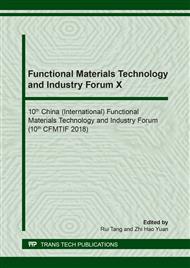p.121
p.128
p.135
p.141
p.151
p.159
p.165
p.171
p.176
Study on the Preparation Technology and Regeneration Technology of Activated Carbon
Abstract:
Due to the developed pore structure ,high specific surface area, low cost, accessible raw materials and stable physical and chemical properties, activated carbon has caused high attention of society. Nowadays activated carbon has been widely used in capacitor electrode production, water pollution treatment, medicine and other fields. We review the various preparation methods of activated carbon and analyze the advantages and disadvantages of them in this paper. The characteristics of activated carbon regeneration technology are also discussed from the perspective of improving the utilization rate of activated carbon. With the development of China's green economy and the increasing awareness of people's environmental protection, the research on the preparation and regeneration of activated carbon will surely have a broader development prospect.
Info:
Periodical:
Pages:
159-164
Citation:
Online since:
June 2019
Authors:
Keywords:
Price:
Сopyright:
© 2019 Trans Tech Publications Ltd. All Rights Reserved
Share:
Citation:


